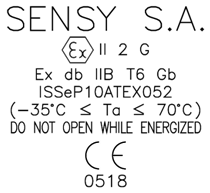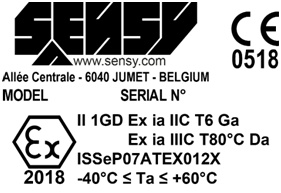ATEX LOAD CELLS REGULATION
ATEX regulation (ATEX for ATmospheres Explosibles in French) is based on two European Directives (2014/34/EU or ATEX 95 for equipment intended to be used in ATEX zones, and 1999/92/EC or ATEX 137 for worker safety).
This regulation requires all company directors to control the risks related to the explosion of these atmospheres in the same way as all other occupational risks. To achieve this, an assessment of the explosion risk in the company is necessary to identify areas where hazardous explosive atmospheres may occur. In accordance with Directive 1999/92/EC, ATEX areas must be subdivided into zones: 0, 1 or 2 for gases, and 20, 21 or 22 for dust.
HAZARDOUS AREAS
Zone 0 :
A place in which an explosive atmosphere consisting of a mixture with air of flammable substances in the form of gas, vapour or mist is present continuously, for long periods or frequently.
Zone 1 :
A place in which an explosive atmosphere consisting of a mixture with air of flammable substances in the form of gas, vapour or mist is likely to occur occasionally in normal operation.
Zone 2 :
A place in which an explosive atmosphere consisting of a mixture with air of flammable substances in the form of gas, vapour or mist is not likely to occur in normal operation but, if it does occur, will persist for a short period only.
Zone 20 :
A place in which an explosive atmosphere in the form of a combustible dust cloud in air is present continuously, for long periods or frequently.
Zone 21 :
A place in which an explosive atmosphere in the form of a combustible dust cloud in air is likely to occasionally occur in normal operation.
Zone 22 :
A place in which an explosive atmosphere in the form of a combustible dust cloud in air is not likely to occur in normal operation but, if it does occur, will persist for a short period only.
SENSY ATEX product marking


Example of marking: II 1 GD:
- The first part indicates its place of use (I for mines, II for above-ground industries such as chemistry and petrochemicals;
- The second part indicates the category: 1 for material installed in zones 0 and 20 or less, 2 for material installed in zones 1 and 21 or less, and 3 for material installed in zones 2 and 22;
- The third part indicates the zone type – G for gas zones (0, 1, 2), D for the dust zones (20, 21, 22).
As regards electrical equipment, a complementary marking enables identification of the protection mode:
Example: Ex ia IIC T6 Ga
The Ex code corresponds to the IEC (international) standard.
The second part comprises one or several letters such as "d" for an explosion-proof device, "e" for increased safety, "ib or ia" for intrinsic safety, but also "m", "q", etc.
The third part shows the gas group:
| Gas group | Representative gas | Minimum ignition energy |
|---|---|---|
| I | methane | 300 µJ (300.10⁻⁶J) |
| IIA | propane | 240 µJ (240.10⁻⁶J) |
| IIB | ethylene | 70 µJ (70.10⁻⁶J) |
| IIC | dihydrogen et acetylene | 17 µJ (17.10⁻⁶J) |
The next part is the equipment’s maximum surface temperature: T1: 450 °C, T2: 300 °C, T3: 200 °C, T4: 135 °C, T5: 100 °C and T6: 85 °C. This means, in case of fire, for example, a T6 cabinet containing flammable products, that its temperature will not exceed 85°C.
The last part corresponds to the level of protection of the equipment (from a to c) in the zone (G for gas, D for dust).
The number mentioned below the CE marking corresponds to the number of the ‘third-party’ certification body.
OBLIGATIONS
This Directive explains the obligations of manufacturers, importers and assemblers of ATEX equipment as regards their marketing. Category 1 has the highest level of requirement with validation of the prototype, the production line and the instruction manual by a notified body, for example.
Directive 94/9/EC is replaced by the new ATEX Directive 2014/34/EU which was published on 29 March 2014. It has been applicable since 20 April 2016.
Directive 99/92/EC corresponds to the user’s obligations. It specifies that the employer has to carry out an explosion risk assessment and classification of the areas where hazardous explosive atmospheres may occur in zones and give an ATEX risk-awareness training to the employees concerned, which means to its employees but also to employees from external companies. All these risks as well as the additional analyses and the measures taken should be recorded in the DRPCE (explosion protection document) which is annexed to the single risk assessment document.
NATURE OF EXPLOSIVE ATMOSPHERES
- vapour from flammable liquids (ethanol, acetone, toluene, kerosene, gasoline, etc.)
- flammable gases (methane, propane, butane, hydrogen sulphide, etc.)
- explosive dust clouds (corn, flour, organic powder, etc.)
- mist from flammable liquids (aerosol, etc.).
STANDARDS
IEC 60079 corresponds to the application of the ATEX Directive, IEC 60079-0 being the general standard. SENSY is certified according to two different protection methods:
- Explosion-proof enclosure "d", according to IEC 60079-1: an enclosure resistant to the explosion of its internal volume and not transmitting this explosion; contains the parts that can cause ignition. This means that the explosive material can enter the enclosure, but an explosion inside cannot spread to the outside. This material may be installed in zones 1 and 2.
- Intrinsic safety "i", according to IEC 60079-11: a circuit which, under normal conditions, cannot produce sparks or heating sufficient to cause the ignition of the explosive atmosphere. SENSY is Ex ia certified corresponding to the number of faults that the circuit can accept (2). This material may be installed in zones 0, 1 and 2; 20, 21 and 22. The use of Zener barriers or galvanic isolators, limiting the power transmitted to the sensor, is then necessary.
SENSY IECEX AND CSA CERTIFIED LOAD CELLS
Our load pins 5000, 5300, 5600, 5560, weighing load cell model 2600, pancake load cell referred to as 2960 and load cells 5100 are also IECEx (international standards) and CSA (North America) certified for use in hazardous areas.
